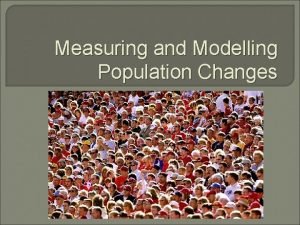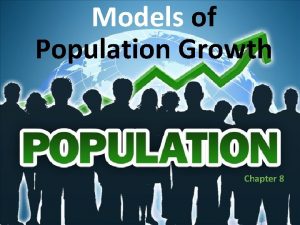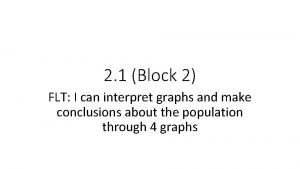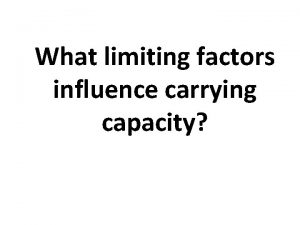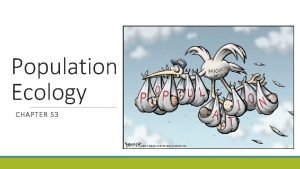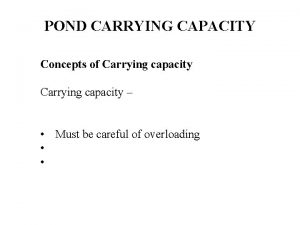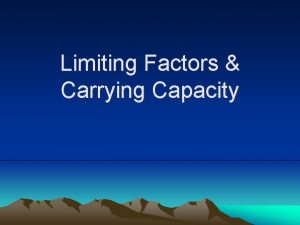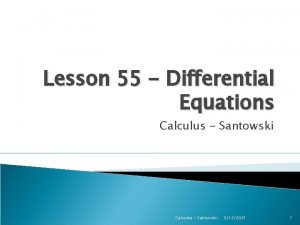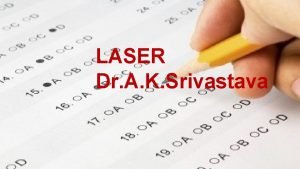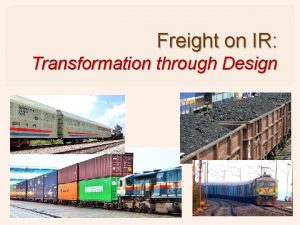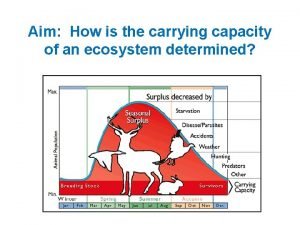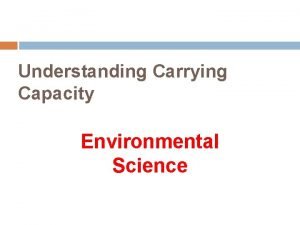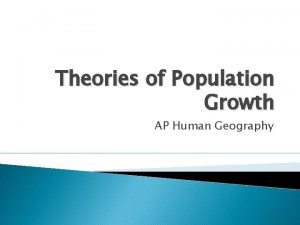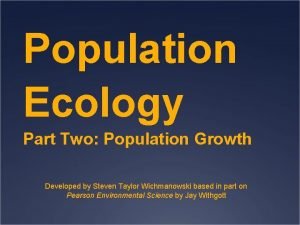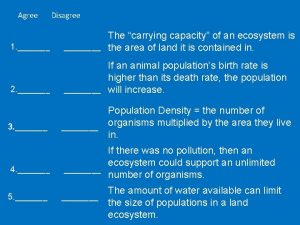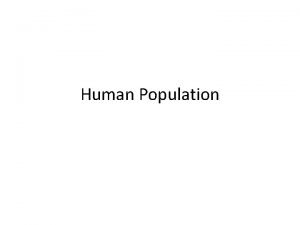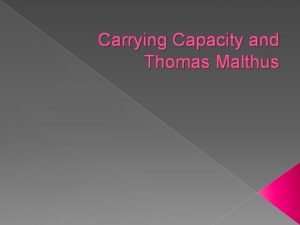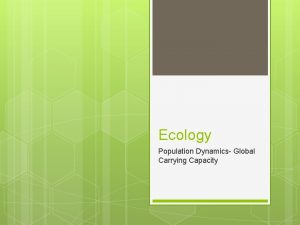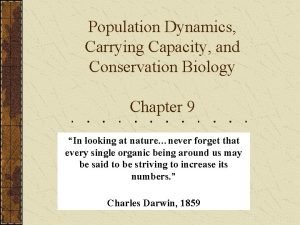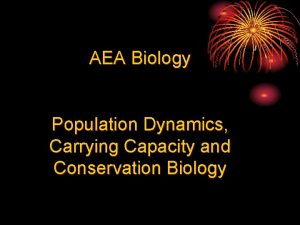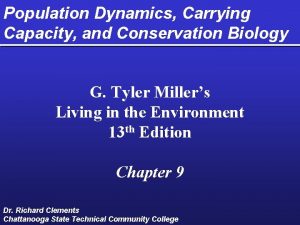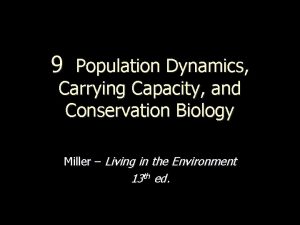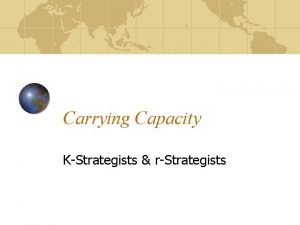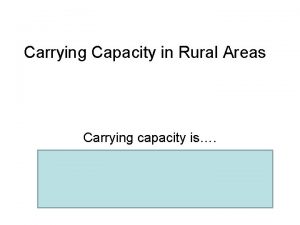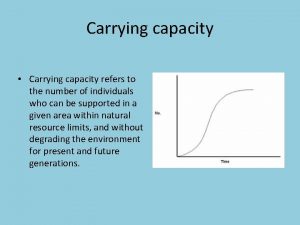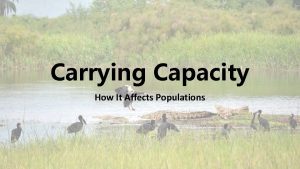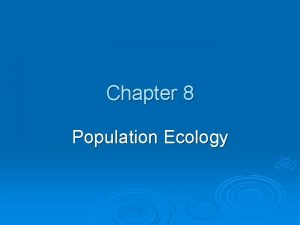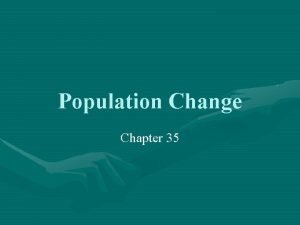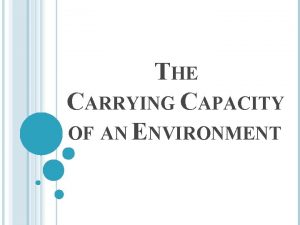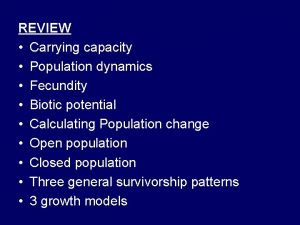Chapter 9 Population Dynamics Carrying Capacity and Conservation



















- Slides: 19

Chapter 9: Population Dynamics, Carrying Capacity, and Conservation Biology

Population Dynamics and Carrying Capacity Population: The individuals that belong to the same species and live in a given area at a particular time. There are 5 basic characteristics of a population: • Population size (N) The total number of individuals within a defined area at a given time. • Population density The number of individuals per unit area at a given time. • Population distribution A description of how individuals are distributed with respect to one another (e. g. clumped). • Sex ratio The ratio of males to females in a population. • Age structure A description of how many individuals fit into particular age categories in a population.

The exponential growth model describes populations that continuously increase Population growth models Mathematical equations that can be used to predict population size at any moment in time. Population growth rate The number of offspring an individual can produce in a given time period, minus the deaths of the individual or its offspring during the same period. Intrinsic growth rate (r) The maximum potential for growth of a population under ideal conditions with unlimited resources. Exponential growth model (Nt = N 0 ert ) A growth model that estimates a population’s future size (Nt ) after a period of time (t), based on the intrinsic growth rate (r) and the number of reproducing individuals currently in the population (N 0). J-shaped curve The curve of the exponential growth model when graphed.

The Exponential Growth Model When populations are not limited by resources, their growth can be very rapid. More births occur with each step in time, creating a Jshaped growth curve.

The logistic growth model describes populations that experience a carrying capacity Populations do not typically experience exponential growth indefinitely. They are limited by resources and carrying capacity. Limiting resource A resource that a population cannot live without and that occurs in quantities lower than the population would require to increase in size. Carrying capacity (K) The limit of how many individuals in a population the environment can sustain.

The logistic growth model describes populations that experience a carrying capacity The logistic growth model is more realistic because it incorporates environmental limits. Logistic growth model : describes a population whose growth is initially exponential, but slows as the population approaches the carrying capacity of the environment.

The Logistic Growth Model As the population becomes larger, however, resources become scarcer, and the growth rate slows. When the population size reaches the carrying capacity of the environment, growth stops. As a result, the pattern of population growth follows an S-shaped curve. Overshoot When a population becomes larger than the environment’s carrying capacity. Die-off A rapid decline in a population due to death.

Factors Affecting Population Size http: //www. slideshare. net/kingcobra 2012/261 -4217

Population size is affected by density-dependent and density-independent factors Factors that influence population size are either density-dependent or densityindependent. • Density-dependent factor A factor that influences an individual’s probability of survival and reproduction in a manner that depends on the size of the population. • Density-independent factor A factor that has the same effect on an individual’s probability of survival and the amount of reproduction at any population size.


Population Curves

Role of Predation


Reproductive strategies and distinct survivorship curves K-selected species A species with a low intrinsic growth rate that causes the population to increase slowly until it reaches carrying capacity. r-selected species A species that has a high intrinsic growth rate, which often leads to population overshoots and die-offs.

Reproductive Strategies

Survivorship Curves… distinct patterns of species survival as a function of age. There are three types of survivorship curves: • Type I survivorship curve A pattern of survival over time in which there is high survival throughout most of the life span, but then individuals start to die in large numbers as they approach old age. • Type II survivorship curve A pattern of survival over time in which there is a relatively constant decline in survivorship throughout most of the life span. • Type III survivorship curve A pattern of survival over time in which there is low survivorship early in life with few individuals reaching adulthood.

Survivorship Curves K-selected species tend to exhibit type I curves r-selected species tend to exhibit type III curves

Conservation Biology Uses the best available science to take action and preserve species and ecosystems www. see-change. org. auc Goals: • Investigate human impacts on biodiversity • Develop practical approaches to maintaining biodiversity Concerns: 1. Endangered species management 2. Wildlife reserves 3. Ecological restoration 4. Ecological economics 5. Environmental ethics

 Relationship between population and carrying capacity
Relationship between population and carrying capacity Carrying capacity population
Carrying capacity population Chapter 4 population ecology answer key
Chapter 4 population ecology answer key Chapter 4 section 1 population dynamics study guide
Chapter 4 section 1 population dynamics study guide Population ecology section 1 population dynamics answer key
Population ecology section 1 population dynamics answer key Population ecology section 1 population dynamics
Population ecology section 1 population dynamics Exponential growth and carrying capacity
Exponential growth and carrying capacity Limiting factors examples
Limiting factors examples Carrying capacity example
Carrying capacity example Carrying capacity of pond
Carrying capacity of pond Whats carrying capacity
Whats carrying capacity Differential calculus
Differential calculus Information carrying capacity of hologram is
Information carrying capacity of hologram is Boxns wagon full form
Boxns wagon full form Carrying capacity diagram
Carrying capacity diagram Carrying capacity graph
Carrying capacity graph Ernst ravenstein ap human geography
Ernst ravenstein ap human geography Carrying capacity exponential growth
Carrying capacity exponential growth Carrying capacity
Carrying capacity Carrying capacity
Carrying capacity
